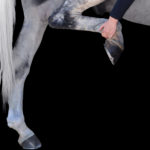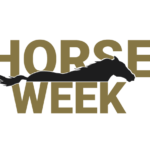The U.S. Equestrian Federation wants all you riders, drivers, owners, trainers and fans to have company–and lots of it.
At its annual meeting, which ended yesterday, the emphasis was on getting more people involved with horses in one way or another at all levels, and promoting the horse/human bond. A greater equestrian constituency in turn helps generate sponsorship, as do medals won in such key competitions as the Olympics.
And what helps to win those medals? Having funds available for training and competition abroad to hone skills. That’s where more sponsorship comes in.
While the concept of achieving expansion, offering greater appeal to youth, making the sport easier to watch and understand and other goals were outlined in rather general terms, there is, as USEF President Chrystine Tauber called it, “the plan,” a long-range roadmap to achieving lofty ambitions, from an increase in membership to higher visibility for horse sports in the media and for the viewing public.
In the old days, the governing body’s “convention,” as it used to be called when it was the American Horse Shows Association, offered several social occasions, and even outings to a nearby showplace farm or facility (that’s how I had a chance to see the Budweiser Clydesdales’ elegant home in Missouri), as well as a opportunity to mingle with leaders of the sport. Forums often were lively; a classic was the time George Morris woke everyone up when he quipped, “Death is a beautiful thing,” referring to shows that he felt weren’t up to snuff and should fall by the wayside.
It’s all different now, and mostly all business.
The major work on rule changes and issues is done in meetings of affiliates, such as the U.S. Eventing Association, with everything coming to USEF for final approval before it goes into the rulebook.
Broader issues are discussed by the USEF board, slimmed down to a mere 19 members, who deal with the direction in which the organization is headed. At this meeting, the spotlight was on addresses by new blood in the form of CEO Chris Welton, who came on board in June; chief commercial officer Josh Taylor and director of sport Will Connell (both of whom were on deck as of last autumn).
I talked to Chris about where the USEF is going and how it will get there. Click on the video to learn what he had to say.
Zooming in on specifics, matters of safety and horse welfare always are paramount for the board. It passed a “return to play” measure for junior riders that delineates when they can get back in the game after a concussion to avoid permanent injury.
The always-helpful safety guru, Malcolm Hook, noted adolescents and those over 65 are most susceptible to concussion. He added that 48 states have laws regulating youth in sport and concussion, though most of that pertains to high school and league sports. Eventing has return to play specs for all riders, junior and senior. Expect this initiative to expand to riders over 18 throughout the USEF breeds and disciplines at some point in the near future. Malcolm said representatives of a number of breeds have wondered, “Why not adults?”
Another item that will come as welcome news is standardizing the vaccinations that recognized shows can require. Dr. Stephen Schumacher, the USEF’s chief administrator for drugs and medications, said some shows were requiring a slew of innoculations that were excessive. Now, when it comes to competition requirements, only shots for highly communicable rhinoneumonitis and influenza will be mandated within six months of showing. Steve emphasized that while vaccinations are vital, biosecurity cannot be ignored just because a horse has been innoculated. The USEF has just put out a new pamphlet on biosecurity listing steps to take at shows that are geared toward keeping your horse healthy and avoid mass outbreaks, like those that have shut down showgrounds in the past.
Precautions range from not allowing your horse to touch noses with other horses, and asking visitors not to touch him, to staying away from common grazing areas and disinfecting any equipment that has to be shared among horses.
As always, some issues did not get resolved and will be dealt with later this year or after that. One is the updated and detailed pony measurement procedure, or “verification” of pony heights. This has been incredibly controversial (how would you feel if you thought you bought a large pony and it turned out to be 14.3 hands, an inch over the cutoff for that category?)
But Bill Moroney, president of the U.S. Hunter Jumper Association (which spent a long time dealing with the measure last month), is confident it will pass at the board’s midyear meeting with a few “tweaks.” By the time it likely will go into effect Dec. 1, a new, more accurate measuring stick should be available that will standardize measurements and make sure the pony who’s 13.1 hands in Des Moines is also 13.1 hands in Dallas.
Another topic that has been delayed is how to handle mileage protection for a long-running series of shows under one management company, in order to provide an opportunity for new shows to get a toe in the water. A task force came up with the idea of having the seventh week of a multi-week show lose its date protection for that seven-day period so a new high-level show–possibly in the same neighborhood–can have a go.
The first show could run classes on week seven, but it will have to deal with having another competition on those dates. Call it free market capitalism. As Chrystine pointed out, however, it’s too late to put in that provision this year, as the season already is well under way.
There also is a question of whether the situation should be handled with, perhaps, a presidential prerogative, like a modification for one year to see how things go, rather than a rule change. At the moment the situation only involves the HITS shows in Ocala and the Winter Equestrian Festival in Wellington, both a few hours from each other in Florida, and Chrystine is wary of putting something in the rulebook that applies solely to a limited situation. That’s especially true now, since Chris Welton told those in attendance that one goal is to cut additions to the already voluminous rulebook by 40 percent.
While the meeting mostly is work, work, work, there are two big dinners that are always a part of the gathering.
The Pegasus Awards were presented Friday night to so many people deserving of recognition. It’s nice to see those who have given back to the sport over the decades get to get to take a bow.
One I felt particularly good about was David Distler, who I’ve known since he manned the in-gate at the Sussex County, N.J., show in the early 1970s. David, who received the Pegasus Medal of Honor, has come a very long way since then. His duties and accomplishments, past and present, are too long to list, from being co-manager of the Devon Horse Show, U.S. steward general for jumpers, judge at the Olympics and World Equestrian Games, USHJA jumper vice president and on and on. If you need to know something about the sport from back in the mist of years gone by, he’s your man, or if it’s a current rule, he’s there with that, too. He is totally dedicated and a key figure in moving the sport along.
Judy Werner, a former USEF vice president who also served as president of the American Saddlebred Horse Association, got to wear the silver cowboy hat trophy emblematic of the Jimmy Williams’ Lifetime Achievement Award. A video of her life detailed her dedication to the sport and governance, and also included a personal side. I loved her story about wanting a certain horse, and finding out her efforts to buy it had come to nought.
 Judy Werner tries on the silver cowboy hat that goes with the USEF’s Lifetime Achievement Award, as USEF President Chrystine Tauber stands by to assist. | Photo copyright 2015 by Nancy Jaffer
Judy Werner tries on the silver cowboy hat that goes with the USEF’s Lifetime Achievement Award, as USEF President Chrystine Tauber stands by to assist. | Photo copyright 2015 by Nancy JafferGiving up, when her husband asked her what she wanted for Christmas, she said with resignation “a string of pearls.” But when she opened the box that she thought contained the pearls, instead of jewelry there was a photo of the mare she wanted. Her husband (who she said never told her “no”) had bought the horse and surprised her with it.
The Junior Equestrian of the Year trophy, which in the past has gone to such notables as Laura and Wendy Chapot, Molly Ashe and Ray Texel, was given this year to 17-year-old para dressage rider Sydney Collier.
 USEF Junior Equestrian of the Year Sydney Collier with her brother Alex; her dog, Journey; USEF board member Howard Simpson and USEF President Chrystine Tauber | Photo copyright 2015 by Nancy Jaffer
USEF Junior Equestrian of the Year Sydney Collier with her brother Alex; her dog, Journey; USEF board member Howard Simpson and USEF President Chrystine Tauber | Photo copyright 2015 by Nancy JafferSydney, who last month received the “Against All Odds” award from the FEI (international equestrian federation) in Baku, Azerbaijan, is an inspiration to everyone. Smiling brightly from her wheelchair, with her fabulous service dog, Journey, by her side (this is a poodle whose intelligence, manners and presence surpass those qualities in many humans), Sydney is a living embodiment of the spirit’s resiliance.
She was diagnosed at age seven with Wyburn-Mason Syndrome, which causes vascular malformations deep within one hemisphere of the brain that are inoperable, as well as numerous side-effects. Sydney was losing vision in her right eye and having coordination issues on the left side of her body. The rider has had three brain surgeries and suffered a stroke, but she has never let anything stop her from getting out of her wheelchair, getting on her horse and competing.
A lively conversationalist, she eagerly responded to my questions about Journey (the first service dog ever to visit Azerbaijan, where they were incredulous that he had never bitten anyone. I guess that says something about the state of canines over there.)
Watch the video to see what Sydney had to say.
Sydney was inspired at the 2010 Alltech FEI World Equestrian Games by para rider Jonathan Wentz. She still wears a bracelet with his name on it, which she pulled up her sleeve to show me, and carries his photo in her pocket when she competes. His death shortly after he achieved his goal of riding in the 2012 paralympics in London was a blow, but she continued her quest to reach her goal — the 2014 WEG, and achieved. Next up, the paralympics.
Her family is there to support her and like the rest of us, marvel at her resolve.
“For me,” said her mother, Anna Collier, “the proudest moment was watching Sydney realize that even as an individual with disabilities, there was nothing she couldn’t do.”
When Sydney was in a neurological rehab center between the ages of 12 and 13, there was a moment of truth as she interacted with the other patients.
“Watching her go and share with other kids that personal acceptance, that they are still the same wondrful people with the same goals and dreams, was the biggest moment of my life in realizing what an inspirational person she is,” Anna continued. “She’s my hero.”
The next night was the Horse of the Year dinner, during which high score awards in a variety of categories are given out. From Morgans and Arabians to hunters and jumpers, proud owners collected the prizes they earned for a season of hard work.
 Cortes C, Beezie Madden’s WEG double bronze medal mount, took the U.S. Equestrian Federation’s International Horse of the Year honors.| Photo copyright 2014 by Nancy Jaffer
Cortes C, Beezie Madden’s WEG double bronze medal mount, took the U.S. Equestrian Federation’s International Horse of the Year honors.| Photo copyright 2014 by Nancy JafferThe two biggest awards, however, are the National and International Horse of the Year, chosen among a group of distinguished competitors.
I have attended a lot of award dinners, but never have I seen a winner as enthusiastic as Beth Kornegay of New Smyrna Beach, Fla., who exploded in excitement when her Friesian, Elis GV, was announced as the winner of the National Horse of the Year title. She her picture at www.facebook.com/EquiSearch
She did the whole fist pump thing, several times and literally jumped in joy up to the stage. And I should put in a word about her trainer, Bruce Griffin. He has been nominated three times for Equestrian of the Year, and hasn’t won. Yet.
He appears to be a stellar individual of great character, evidenced in his acceptance speech for the Barbara Worth Oakford Trophy, given to an equestrian showing in a non-reining western discipline.
Elis the Friesian does more than western — his repertoire includes dressage, in-hand, hunter and driving. That’s not the half of it, but I have only so much space. Many of the points Elis earned were put on him by Bruce’s daughter, Janae, only 9 years old.
The biggest winner on the awards front was show jumper Beezie Madden, the queen of calm, cool and collected. An amazing rider, she also is diligent about giving back to her sport, serving conscientiously on the USEF board.
 Beezie Madden got her record fourth Equestrian of the Year title at the USEF’s Pegasus dinner, where former USEF President David O’Connor made one of the presentations. | Photo copyright 2015 by Nancy Jaffer
Beezie Madden got her record fourth Equestrian of the Year title at the USEF’s Pegasus dinner, where former USEF President David O’Connor made one of the presentations. | Photo copyright 2015 by Nancy JafferShe took the Equestrian of the Year title for a record fourth time, and her Alltech FEI World Equestrian Games double bronze medal mount, Cortes C, was International Horse of the Year.
Next up for me postcard-wise is the 5-star dressage show at the Adequan Global Dressage Festival next month. I’ll take in a little show jumping, too, while I’m in Wellington.
Until then,






